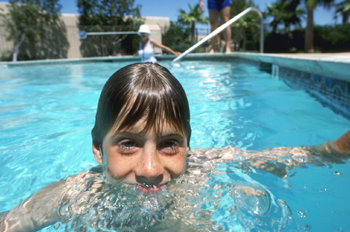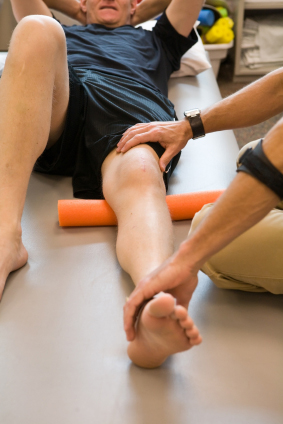Physical Therapy and Exercise
 Physical therapy (PT) is treatment to keep your joints and muscles working the way they should. Physical therapy is also used after an accident, surgery, or a bleed to get your joints and muscles back in shape. It is a very important part of hemophilia care.
Physical therapy (PT) is treatment to keep your joints and muscles working the way they should. Physical therapy is also used after an accident, surgery, or a bleed to get your joints and muscles back in shape. It is a very important part of hemophilia care.
The physical therapist is part of the team at your HTC. She or he will work with your doctors to plan your care. They will look at strengths and weaknesses and then plan a program to suit your needs. Your PT program can get you ready to play sports and do other activities for exercise and fun.
By doing physical therapy, your muscles will be stronger and your joints will work better. This means you will have fewer bleeds. You may also feel better and be able to do more things. You will need less rehabilitation in the future. Rehabilitation is treatment to restore a damaged joint or muscle. It is important that a joint or muscle works as well after a bleed as it did before.
Remember: If you don't exercise your muscles, they will become weak. Staying active keeps them strong.
How physical therapy (PT) keeps joints and muscles healthy
- PT builds muscles that are strong enough to support and protect the joints. This means fewer bleeds.
- PT works on the areas where you are weakest. You learn how to improve your fitness level. By doing the right exercises, you can stay in top shape.
- PT makes you more flexible and gives you better balance. This helps you have fewer accidents as you move around.
How physical therapy (PT) restores or rebuilds joints and muscles (rehabilitation)
- PT can make a joint less stiff and keep the muscle strong after a bleed. The physical therapist can teach you exercises to bring muscles back to their normal, healthy state. A joint or muscle that is not brought back into shape is more likely to bleed again.
- PT can help you have less pain and discomfort.
- PT gets you up and moving sooner after a bleed or surgery.
- Part of PT is showing you the right way to use crutches, braces, or splints. You may need these for support, to correct a problem, or to help you get motion back. The physical therapist will check to see how well these things are working.
Rehabilitation after surgery
Sometimes you may have problems with your joints and muscles even though you are doing everything right. Surgery may be needed to fix the problem. PT is very important after an operation. You should keep doing your exercises until the joint or muscle works as well as before.
Everyone with hemophilia needs a physical therapy check-up every year!
Every person with hemophilia needs a regular check-up by a physical therapist who knows about hemophilia. The physical therapist at your HTC is aware of the problems caused by bleeding into joints and muscles. She or he is trained to plan a special program geared to your age, needs, and interests.
It is best to work with the physical therapist who is part of your treatment center. She or he has the special training in hemophilia that you need. If you live far from the treatment center but need to have PT often, ask the center physical therapist to contact a physical therapist near your home. She or he can give advice about your exercise program.
 The role of the physical therapist
The role of the physical therapist
A physical therapist is trained to find and treat muscle, joint, and nerve problems that are caused by injury or disease. Your PT program may include treatments at the physical therapist's office as well as exercises you do at home. A physical therapist is also skilled in teaching you ways to reduce and control pain.
The physical therapist who plans your program thinks of you as a whole person, not just your arm, your leg, or your elbow. She or he will design a program that fits your needs. The physical therapist considers your physical condition, what you like to do, and your lifestyle.
A big part of the physical therapist's job is getting you to follow the program. If you do not do the exercises and follow the plan, it will not help. So the physical therapist works to encourage you and your family. A good physical therapist is easy to talk to and understand. She or he will not only show you how to do an exercise but will explain why it helps.
The physical therapist needs to know about you
The physical therapist who plans your program will want to know about your lifestyle, your interests, and how active you are. She or he will want to know if your family is able to help with your treatments. After asking you questions, the physical therapist may do some or all of these tests:
- Range of motion tests - these show how well your joints can move, bend, and stretch.
- Gross manual muscle tests - these measure how strong your muscles are and find your weak spots.
- Functional tests - these tell if you need help from braces, splints, or crutches.
- Gait pattern tests - these show the way you walk on level and raised surfaces.
- Leg length tests - these check to see if both legs are the same length. If they are not, the unequal stress on the joints could cause bleeds.
- Circumference measurements - these measure the distance around joints and muscles to see if they are changing size.
The physical therapy plan
The physical therapist will plan a program for you. The major parts are:
- Treatments or exercises to help you get back lost strength, motion, or use of a muscle or joint. The plan works to make joints move better and to make muscles stronger.
- Advice on which sports and activities will keep you in the best shape.
- Teaching good "body mechanics". This means showing you how to move your body so that it works well without putting too much stress on your joints.
- Regular check-ups to look for changes in muscles and joints. A change in size may show a need for other treatments.
Treatments other than exercise
A physical therapist might tell you to use one or more of these:
- Exercise in a pool, hot soaks in a tub, or whirlpool baths. It is easier to move your body in water.
- Splints, crutches, or braces. These can help rest or protect part of your arm or leg.
- Ice packs to ease pain and help relax muscles.
- Biofeedback. This is training to help you be more aware of when muscles are tense.
